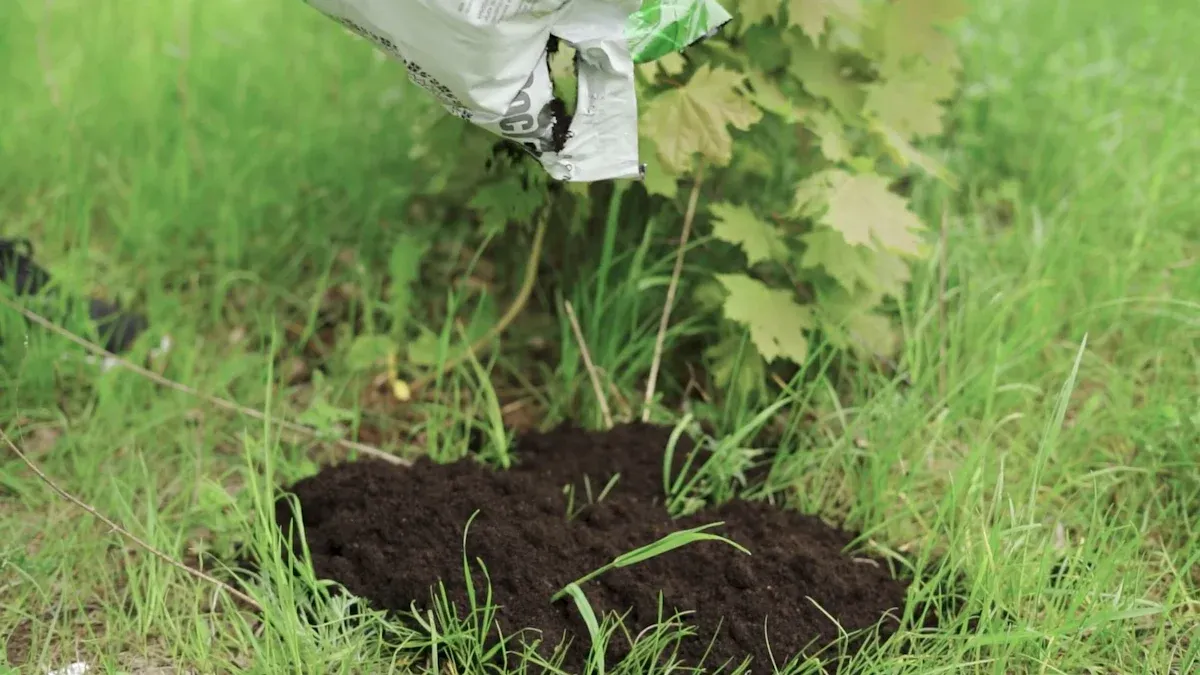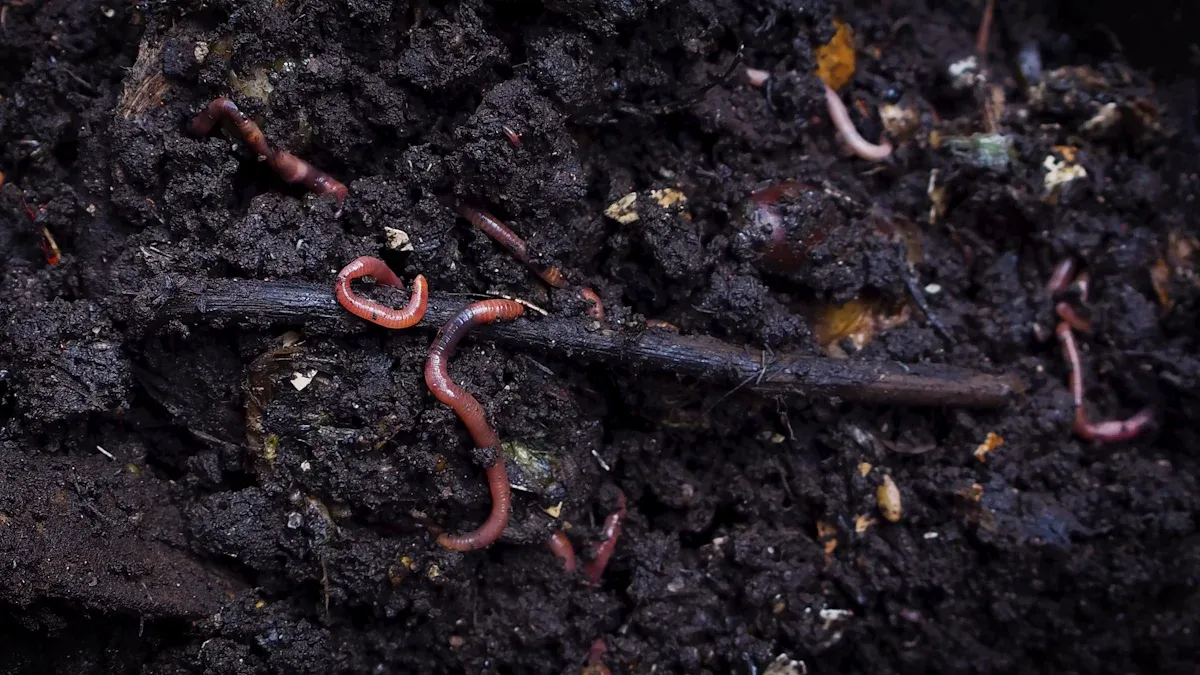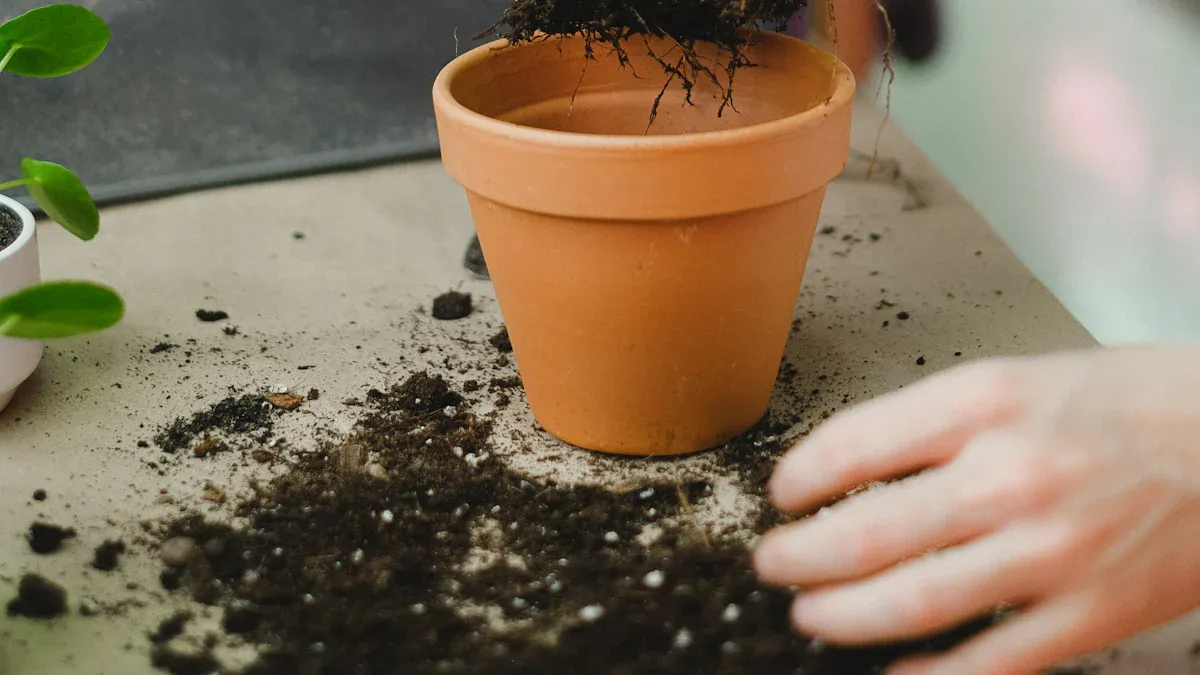What Are the Benefits of Humic and Fulvic Acids for Plants and Animals

You can experience many humic and fulvic acid benefits for both plants and animals. These natural acids play a crucial role in keeping soil healthy, promoting better plant growth, and increasing crop yields. For instance, applying humic acid alongside phosphorus fertilizer boosted barley grain production by up to 64% in challenging soil conditions.
In addition to supporting plants, humic and fulvic acid benefits extend to animals by improving digestive health and helping eliminate harmful substances from their bodies. Research indicates that these acids enhance food digestion and toxin removal in animals. Utilizing humic and fulvic acids reduces the need for synthetic chemicals, benefiting the environment for both plants and animals.
Key Takeaways
Humic and fulvic acids help plants grow better. They let roots take in more water and nutrients. This makes plants stronger and gives more crops.
These acids make soil better by holding more water. They also make soil softer and help good microbes live there. This gives plants a healthier place to grow.
Humic and fulvic acids help animals digest food better. They make animals' immune systems stronger. They also help animals get rid of toxins. This helps animals grow strong and healthy.
You can put humic and fulvic acids on soil, leaves, or seeds. This helps plants grow more. Adding them to animal feed or water helps animals stay healthy and gain weight.
Using the right amount of humic and fulvic acids is important. It means you need less chemical fertilizer and medicine. This makes farming safer and better for nature.
What Are Humic and Fulvic Acids
Definition and Source
Humic and fulvic acids are found in most soils and water. These substances form when plants and animals break down over time. They come from things like peat, compost, soft coals, and some fertilizers. Scientists use new ways to get more humic and fulvic acids from these sources. Some of these ways are gravimetric analysis and ultrasound-assisted extraction. These methods help people get better humic substances for plants and soil.
Key Differences
Humic and fulvic acids look alike but are not the same. They have different chemical makeups and work differently in soil and plants. The table below shows some main properties:
Property/Parameter | Humic Acids (HA) | Fulvic Acids (FA) |
|---|---|---|
Less than FA | More than HA | |
Phenolic to carboxylic group ratio | 0.48 ± 0.10 | 0.23 ± 0.05 |
Apparent Molecular Weight (Da) | ~2600 | ~1800 |
Proportion of DOC (%) | ~10 | |
Total Acidity (% of O/C ratio) | 29–32% | 48–57% |
Humic acids have bigger molecules and do not dissolve well in water. Fulvic acids have smaller molecules and dissolve easily. Fulvic acids have more carboxylic groups, so they hold onto nutrients better. These differences change how humic and fulvic acids help plants and soil.
How They Work
Humic and fulvic acids help plants and soil in many ways. They act like natural chelators and grab nutrients for plants. Humic substances make soil better, so roots can grow deeper and get more water and food. Fulvic acids are small and move fast through soil and plant cells. They carry nutrients to where plants need them.
Scientists study how humic and fulvic acids work by looking at their acid–base properties and how they bind protons. These acids change how nutrients move in soil and water. They also help plants deal with stress and help good microbes grow. Using humic and fulvic acids gives plants a better chance to grow strong and healthy.
Humic and Fulvic Acid Benefits for Plants

Nutrient Uptake
Humic and fulvic acids help plants take in more nutrients. These acids make it easier for roots to get food from the soil. Fulvic acids help move nitrogen, phosphorus, and other nutrients into plants. For example, using fulvic acid at 120 mg·L−1 helps roots get 1.7 times more nitrogen. Stems get 2.67 times more, and leaves get 2.78 times more nitrogen than plants without it. The table below shows these results:
Parameter | Fulvic Acid (120 mg·L−1) | Fold Increase vs. Control |
|---|---|---|
15N in Roots | Yes | 1.70 |
15N in Stems | Yes | 2.67 |
15N in Leaves | Yes | 2.78 |
Humic acids grab micronutrients like iron, zinc, and manganese. This makes it easier for roots to use them. Plants grow better because they get more nutrients. Enzyme activities that help with nitrogen also go up. This means plants use food better. These acids help you use less chemical fertilizer. This is good for the environment.
Soil Structure
Good soil helps plants grow strong. Humic and fulvic acids make soil better in many ways. Humic acid can hold a lot of water. This keeps soil wet and means you water less. These acids help soil keep nutrients longer. The table below shows some ways soil gets better:
Measurement / Parameter | Impact |
|---|---|
Water Retention Capacity | Holds more water, keeps soil moist |
Cation Exchange Capacity (CEC) | Retains nutrients, reduces leaching |
Soil Porosity and Aeration | Loosens soil, helps roots grow deeper |
Microbial Activity | Supports beneficial microbes, speeds up nutrient cycling |
Soil Compaction Reduction | Breaks up hard soil, improves root penetration |
Humic substances make soil softer and less packed. Roots can spread out and find more water and food. These acids help good microbes in the soil. Microbes break down old plants and give food to new ones. This makes soil healthier and helps plants grow better.
Stress Resistance
Plants can get hurt by drought, salt, or disease. Humic and fulvic acids help plants fight these problems. These acids make antioxidant enzymes work harder. These enzymes protect plant cells from damage. Fulvic acid also helps plants make more chlorophyll and carotenoids. This helps plants make food even when stressed.
In water systems, these acids help plants use carbon and nitrogen better.
Fulvic acid helps crops like pistachio, eggplant, and tomato get more potassium and zinc.
Plants with fulvic acids have more phenols and flavonoids to fight stress.
You can use these acids to help plants recover from tough times. Humic and fulvic acids help plants stay healthy and grow well.
Growth and Yield
You want your plants to grow big and give more food. Humic and fulvic acids help plants grow and make more crops. Studies show these acids help crops like triticale grow better, even in salty soil. Plants get more nutrients, so grains are heavier and there is more food for animals. Fulvic acid helps alfalfa roots grow more nodules and boosts growth genes. This gives more forage.
Tip: Try humic and fulvic acids on many crops. They work on cereals, beans, vegetables, and fruit trees. These acids help in sandy and clay soils.
Humic substances help seeds sprout and roots grow strong. Plants grow better and give more food. Using these acids means you need less chemical fertilizer and pesticide. This makes farming better for the planet.
Humic and Fulvic Acid Benefits for Animals

Gut Health
It is important for animals to have a healthy gut. Humic and fulvic acids help with this. Adding humic acids to animal food helps good bacteria grow in the gut. In one study, people who took humic acids had 20-30% more good gut bacteria. This means humic acids can help animals too. In fish, fulvic acid in their food changed the gut bacteria. It lowered bad bacteria and raised good ones like Lactococcus and Lactobacillus. These changes help animals digest food better and get more nutrients.
Pigs and chickens also get these benefits. Humic substances help stop gut sickness and make food work better. Animals gain weight faster and use their food well. Fulvic acids protect the stomach lining in rats. This means they help keep the stomach safe. Using humic and fulvic acids helps animals digest food, take in nutrients, and stay healthy.
Animal | Effect of Humic/Fulvic Acids | Outcome |
|---|---|---|
Fish | Improved gut microflora | More good bacteria, better digestion |
Pigs | Better feed efficiency | Faster weight gain, healthier gut |
Rats | Antiulcer effect | Protected stomach lining |
Tip: Try putting humic acid or fulvic acid in your pet or farm animal food. You might see firmer poop, better eating, and more energy.
Detoxification
Animals can get toxins from food, water, and the world around them. Humic and fulvic acids help remove these toxins from their bodies. Scientists tested these acids in mice with liver problems. The results showed humic acids protected the liver and helped clear out bad stuff. In cell tests, humic acid worked well at about 239 µg/mL. After treatment, many liver proteins changed, most linked to detox.
Fulvic acids also help the liver do its job. They lower bad molecules and help the body clean itself. In chickens and fish, fulvic acid raises antioxidant enzymes. These enzymes protect cells and help the body handle stress. Using humic and fulvic acids gives animals a natural way to fight toxins and stay healthy.
Humic acid keeps the liver safe from toxins.
Fulvic acid raises antioxidant enzymes.
Both help remove heavy metals and chemicals.
Immune Support
Animals need strong immune systems to stay healthy. Humic acids and fulvic acids help with this. Studies in chickens, shrimp, and fish show these acids boost immune cells and help fight disease. For example, chickens fed humic acid digested protein better and had more calcium and trace elements. These changes made their immune systems stronger and lowered swelling.
In animal tests, humic acids raised white blood cells and boosted antioxidants. Fulvic acid made enzymes that fight bad molecules work better. In shrimp and fish, fulvic acid helped them fight sickness and infections. You can add humic and fulvic acids to pet, poultry, and livestock food to help them heal faster and stay healthy.
Animal | Substance | Immune Effect | Extra Benefit |
|---|---|---|---|
Chickens | Humic acid | More immune cells, better digestion | Faster growth |
Fish | Fulvic acid | Higher antioxidant enzymes | Better stress resistance |
Shrimp | Fulvic acid | Stronger innate immunity | Improved survival |
Note: Humic and fulvic acids are good natural immune boosters. You can use them instead of antibiotics for animal care.
Growth and Well-being
Animals need to grow well and feel good. Humic and fulvic acids help with this. Adding fulvic acid to animal food helps them live longer, grow faster, and have stronger immunity. In chickens, fulvic acid made them grow faster and use food better. This means animals gain more weight with the same food. In rats, fulvic acid helped them gain weight each day and improved digestion by raising good bacteria and lowering bad ones.
Fish also do better with fulvic acid. In rainbow trout, fulvic acid in water made fish bigger and improved immune health. Fulvic acid helps animals take in nutrients, fight stress, and avoid sickness. You can use humic and fulvic acids in food for pets, poultry, pigs, and fish. These acids help animals grow, stay healthy, and do better.
Fulvic acid helps animals use food and gain weight.
Humic acids help animals absorb nutrients and use energy.
Both help animals handle stress and get better after sickness.
If you want your animals to do well, try adding humic and fulvic acids to their food. You may see shinier coats, more energy, and better results.
How to Use Humic and Fulvic Acids
Application for Plants
There are a few ways to use humic and fulvic acids on soil. You can put them in the soil, spray them on leaves, or soak seeds before planting. Putting acids in the soil gives the biggest boost to crops. Studies show this can make crops grow almost 29% more. Spraying leaves or soaking seeds also helps, but crops grow about 17% more with these ways. For best results, mix the acids into soil before you plant. You can also pour a liquid mix around the roots.
Soil application: Mix granules or liquid into the top layer of soil. This helps soil hold water and stay loose.
Foliar spray: Spray a weak solution right onto the leaves. This lets plants take in nutrients fast.
Seed treatment: Soak seeds in a weak solution before planting. This helps roots grow strong early.
Tip: Use humic and fulvic acids when the growing season starts. You can use them again, but spraying more than four times may not help more.
Dosage for Animals
You can put humic and fulvic acids in animal food or water. Start with a small amount and slowly add more. For chickens and cows, use 0.1% to 0.2% of the total food weight. For pets, follow the label or ask your vet. Studies show these acids help animals use food better and get rid of toxins safely.
Animal Type | Recommended Dose | Application Method |
|---|---|---|
Poultry | 1–2 g/kg feed | Mix with feed |
Livestock | 1–2 g/kg feed | Mix with feed |
Fish | 0.5–1 g/L water | Add to tank/pond |
Pets | As per label/vet advice | Mix with food/water |
Note: Always add new supplements slowly so animals do not get stomach problems.
Safety Tips
Humic and fulvic acids are safe for soil and animals if you use them right. They do not hurt good microbes or the earth. These acids can fight germs and viruses, so they are good for green farming. Do not use too much, because more is not always better. Using too much can waste the product and may not help more.
Keep products in a cool, dry spot.
Wear gloves when you touch strong forms.
Keep acids away from kids and pets when not using them.
Remember: Good soil makes healthy plants and animals. Use the right amount and check how things grow for the best results.
You can boost plant growth, improve soil health, and support animal well-being by using humic and fulvic acids. These natural substances help you grow stronger crops and raise healthier animals with less need for chemicals. Try adding them to your garden or animal feed for better results.
Want to learn more? Look for trusted guides or talk to experts about the best ways to use humic and fulvic acids in your routine.
FAQ
What is the best time to apply humic and fulvic acids to plants?
You should apply humic and fulvic acids at the start of the growing season. Early use helps roots grow strong. You can also use them after planting to support growth and recovery from stress.
Can you mix humic and fulvic acids with other fertilizers?
Yes, you can mix these acids with most fertilizers. They help plants use nutrients better. Always check the product label for mixing instructions. Test a small area first to make sure your plants respond well.
Are humic and fulvic acids safe for pets and livestock?
Humic and fulvic acids are safe for most animals when you use the right dose. Start with a small amount in feed or water. Watch your animals for any changes. Ask your vet if you have concerns.
How long does it take to see results after using humic and fulvic acids?
You may notice healthier plants or animals within a few weeks. Roots often grow faster, and leaves look greener. Animals may show more energy and better digestion. Results depend on the starting health and environment.
